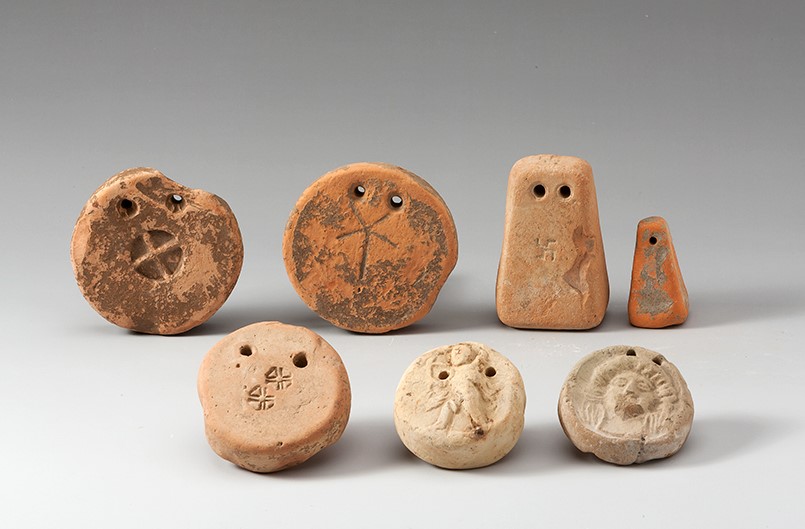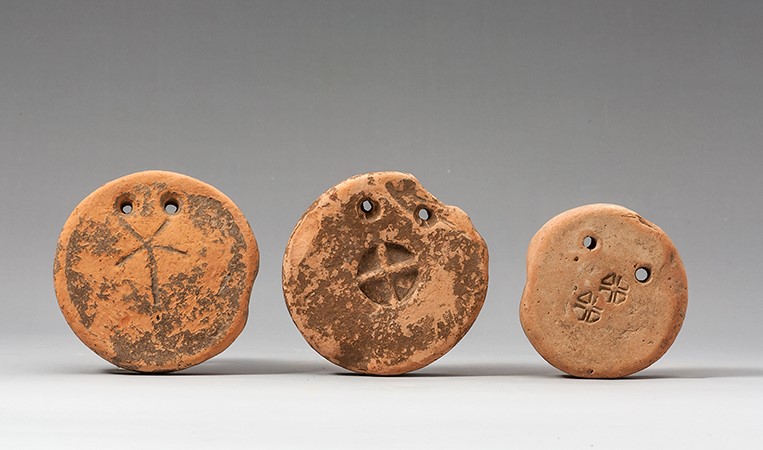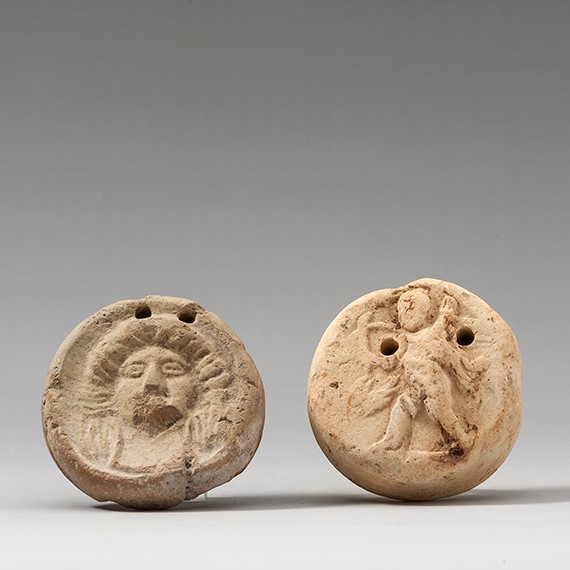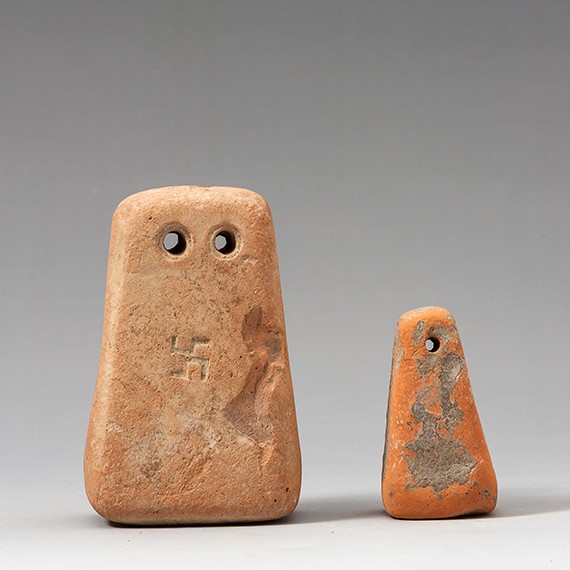Acquisition number: 2001.03
a] Loomweight, rectangular in section, tapering in at the top, pierced twice and decorated with an impressed swastika. Max. ht 9cm; ma. width 5.9cm; depth from 4 to ca 2.4cm (top). Pres. weight 242.5g.
b] Pyramidal loomweight. Ht 5.8cm; max. width 3.1cm. Weight 49g.
c] Disc loomweight with scratched decoration. Diam. ca 9.2cm; thickness ca 1.9cm. Pres. weight 192g.
d] Disc loomweight with an impressed rosette. Diam. 9cm; thickness 2.1cm. Preserved weight 189g.
e] Disc loomweight with two impressed rosettes. Max. diam. ca 7.9cm; thickness 2.2cm. Preserved weight 155.5g.
f] Disc loomweight with a relief of Eros. Diam. ca 6.5cm; thickness ca 2.3cm; thickness incl. relief ca 3cm. Weight 125g.
g] Disc loomweight with a frontal bust in shallow relief. Diam ca 6.6cm; max. thickness ca 2cm. Weight 93.5g.
Title: Seven Greek Terracotta Loomweights - 2001.03
Acquisition number: 2001.03
Author or editor: J.R. Green
Culture or period: Hellenistic.
Date: 4rd - 2nd century BC.
Material: Clay - Terracotta
Object type: Textile production - Loomweight
Dimensions: 40mm (l) × 59mm (w) × 90mm (h)
Origin region or location: Greece
Display case or on loan: 4
Keywords: Greek, Hellenistic, Textiles, Eros, Magna Graecia, Attica
Bonhams and Brooks (London), Sale Cat., 26 April 2001, no. 806 (four of them illustrated).
2001.03
Seven Greek Terracotta Loomweights
Presented by the Friends of the Classics Museum
a] Loomweight, rectangular in section, tapering in at the top, pierced twice and decorated with an impressed swastika. Max. ht 9cm; ma. width 5.9cm; depth from 4 to ca 2.4cm (top). Pres. weight 242.5g.
Smooth, hard-fired, orange-red clay with a few small dark inclusions and some larger deep red. The surface is somewhat worn, chipped in places. Hand-formed but with flat faces. Twin suspension holes above, inset. On the front and on the top, an impressed swastika with one arm slightly shorter than the others.
b] Pyramidal loomweight. Ht 5.8cm; max. width 3.1cm. Weight 49g.
Smoothly-finished, well-levigated orange clay; the surface somewhat worn. Square-sectioned with rounded edges. Single suspension hole above. Undecorated.
Quite possibly Attic, where this type is common in fifth and fourth centuries, though ours is not glazed as Attic often are.
c] Disc loomweight with scratched decoration. Diam. ca 9.2cm; thickness ca 1.9cm. Pres. weight 192g.
Plain circular disc, pair of holes towards one edge. Fairly orange clay with fine dark and small white inclusions. Surface worn; no evidence of slip. Chip (ancient) from one edge. The front and back edges of the holes are shaped for easier threading. What is apparently a cross-torch (Kreuzfackel) is incised on one face. Reverse and edges plain.
There is a very good overall treatment of divinities with such a torch by B. Otto, “Die Göttin mit der Kreuzfackel”, in: Fremde Zeiten. Festschrift für Jürgen Borchhardt, ii (Vienna 1996) 177-186, where she notes that it seems to be associated particularly with Demeter or Persephone, the former above ground, the latter in the Underworld. For examples of terracottas with a female (Demeter or Persephone) holding such a torch, see U.Ch. Kurz, “Büstenprotomen und Büste aus S. Maria d’Anglona”, Jahreshefte des Oesterreichischen Archäologischen Institutes 74, 2005, 225-245, or Lippolis, in: E. Lippolis, S. Garaffo and M. Nafissi (eds), Culti greci in Occidente, I. Taranto (Taranto 1995) 59-60 with pl. 18, 4 and pl. 19,1-2, where he illustrates some figurines from Taranto with females carrying cross-torches; he identifies them as Bendis-Artemis, but this cannot be right: they must be Persephone; also M. Osanna, L. Prandi, A. Siciliano, Culti greci in Occidente, II. Eraclea (Taranto 2008) pl. 10.1-3, pl. 23 (with a discussion of the Demeter sanctuary at the site by B. Otto at p. 65ff). For depictions of the goddess with such a torch, see for example the red-figure volute-krater by the Darius Painter in Toledo, Ohio, e.g. Museum Helveticum 53, 1996, 25-36 (Johnston and McNiven), Mediterranean Archaeology 17, 2004 [2006] pl. 30 (W.J. Slater), where ‘Persephone’ is inscribed by the figure’s head. Slightly later but of the same general appearance is the depiction of Persephone with Hades on the name vase of the Underworld Painter, the volute-krater Munich 3297, A.D. Trendall and A. Cambitoglou, The Red-Figured Vases of Apulia, ii (Oxford 1982) 533 no. 282, pl. 194, A.D. Trendall, The Red Figure Vases of South Italy and Sicily. A Handbook (London 1989) fig. 209. See also the volute-krater published in Corpus Vasorum Antiquorum Japan (2) pl. 51, 3-4 with a scene of the rape of Persphone on the body; Demeter looks on, holding such a torch. Another example is to be found on the recently-published Early Italiote hydria from Saturo where Persephone is present in a scene of Orpheus and Eurydice: Antike Kunst 51, 2008, pl. 10, 3. On the other hand Corpus Vasorum Antiquorum Japan (2) pl. 37, 1, has a plate with an Eros accompanied by a calyx-krater and Kreuzfackel. It was manufactured in the area of Ruvo in the workshop of the Amphorae Painter. From the same workshop is an unpublished Gnathia dish in Berlin (F 3365) with such a torch in front of a female head.
Note too the stone slab decorated with a cross-torch with the accompanying inscription ‘of the priestess of Demeter’, found at Valesio in Messapia in the heel of Italy: G. Pugliese Carratelli (ed.), Italia, Omnium Terrarum Parens (Milan 1989) 654 fig. 437 (De Simone).
All this said, a statue of Artemis is given one on the Apulian red-figure hydria, Berlin F 3164, A.D. Trendall and A. Cambitoglou, The Red-Figured Vases of Apulia, i (Oxford 1978) 170 no. 34; K. Schauenburg, Studien zur unteritalischen Vasenmalerei, XI/XII. Studien zur attischen Vasenmalerei (Kiel 2008) fig. 66a-c.
One observes that the fifth-century votives for Persephone at Camarina in Sicily do not include the motif: cf. F. Giudice, Monumenti Antichi 49, 1979, 282-354. Nor am I sure that I can accept the attempt to link it to a rosette-motif found in Attica: A. Klöckner, “Women’s Affairs? On a Group of Attic Votive Reliefs with Unusual Decoration”, in: J. Dijkstra, J. Kroesen and Y. Kuiper (eds), Myths, Martyrs, and Modernity. Studies in the History of Religions in Honour of Jan N. Bremmer (Leiden 2010) 179-191.
Probably later fourth or early third century BC.
d] Disc loomweight with an impressed rosette. Diam. 9cm; thickness 2.1cm. Preserved weight 189g.
Pinkish-buff clay with a few fine white inclusions; a large, deeply-impressed rosette on one side. The two holes are cut away about their openings to facilitate threading. Smoothly finished but with some substantial ancient chips missing.
Compare 2001.03 [e].
e] Disc loomweight with two impressed rosettes. Max. diam. ca 7.9cm; thickness 2.2cm. Preserved weight 155.5g.
Circular with two widely-spaced holes, ca 5mm internal diameter. Smooth, well-levigated, pinkish-buff clay, somewhat worn, chipped especially to left edge. The surface seems to have once been covered with a cream slip. On the front are two impressed rosettes and there is another on the top edge, positioned centrally between the two holes. The petals comprise triangular outlines with central dot.
For an example with three rosettes, albeit of slightly different form, see G. Sena Chiesa and E.A. Arslan (eds), Miti greci. Archeologia e pittura dalla Magna Grecia al collezionismo (Milan 2004) 412 no. 410 (F. Giacobello), or other versions in A. Carrabba, "Nuovo instrumentum dalla Lucania. Piramidette messapiche", Epigraphica 51, 1989, 85-113, figs 22, 24, 25.
Perhaps still fourth century BC.
f] Disc loomweight with a relief of Eros. Diam. ca 6.5cm; thickness ca 2.3cm; thickness incl. relief ca 3cm. Weight 125g.
Smoothly-finished, cream clay with a few very fine dark inclusions. Circumference somewhat irregular.
In high relief on one side, figure of Eros moving to left, carrying a bow in his right hand and a quiver over his left shoulder. Behind his left shoulder, one of the suspension holes pierces his wing. His drapery flies away to either side of the hips and it partially covers his right upper leg. The groundline on which he moves in clearly shown. One observes that the suspension holes are placed relatively low and were clearly inserted with regard to the figure of the young god, so that when viewed from the rear, their positioning seems eccentric: the image was regarded as important.
The mould was evidently worn at the time of use. One supposes it was taken from another relief, whether in metal or in clay.
From the style of the Eros, after 300 BC. Very close to ours and quite likely of the same series, though also worn, is an example in the Museo Civico of Legnano (Liguria), inv. 833: M. Bonghi Jovino, Documenti di coroplastica italiota, siceliota ed etrusco-laziale nel Museo civico di Legnano (Florence 1972) 82 no. 186, pl. 39. The relief even exhibits some of the same deficiencies. It was formerly part of a private collection developed in South Italy in the 1930s. Three other examples are known to come from Metaponto: Notizie degli Scavi di Antichità, Accademia Nazionale dei Lincei 1936, 446 fig. 9, left; Notizie degli Scavi di Antichità, Accademia Nazionale dei Lincei 1966, 153 no. 21, pl. 5, 3; D. Adamesteanu, D. Mertens and F. D’Andria, Metaponto I, Notizie degli Scavi di Antichità, Accademia Nazionale dei Lincei Suppl. 1975[1980], 288 fig. 300, and another from Pantanello in the territory of Metaponto. These are all worn and/or from worn moulds, and there is a mould taken from another very worn example from Sant'Angelo Vecchio near Metaponto: J.C. Carter et al., Excavations at Metaponto, 1979 (Austin TX 1979) fig. 27. A further example of the same series: U. Hübinger and M. Menninger, Terrakotten der Westgriechen im Akademischen Kunstmuseum der Universität Bonn (Rahden/Westf. 2007) 204 no. 144. It is reasonably thought to have come from Apulia. And then there is one in the Museo Civico in Udine: M. Rubinich, Ceramica e coroplastica dalla Magna Grecia nella Collezione De Brandis (Udine 2006) 235 no. 353 (ill.). What the Eros carries over his left shoulder is not always clear: it sometimes looks like a torch or even, in the case of the Bonn example, an amphora, but the bow in his right hand, which is fairly clear on ours, makes a quiver fairly certain.
g] Disc loomweight with a frontal bust in shallow relief. Diam ca 6.6cm; max. thickness ca 2cm. Weight 93.5g.
The clay has fired grey-brown; some small white and some fine dark inclusions. Chipped at the back below, and round the chin of the figure. Pair of closely-spaced holes above.
One side is almost filled with the bust of beardless male in relief, fully frontal, with striated hair surrounding the head and with ringlets hanging below to the shoulders.
The figure would not seem to have been thought of as masked (i.e. theatrical) despite the damage to the area of the mouth.
Hellenistic.
There has been some debate, especially among Italian scholars, as to whether pieces such as item [f] in this ANU collection of loomweights, with its relief of Eros, are in fact loomweights or, rather, votive pendants. More generally, A.M. Tunzi Sisto, Pesi fittili da Adelfia. Dalla protostoria all’età classica. Tipologia di forme e decorazioni (Storia e fatti di Puglia, 7, Manduria – Bari – Rome 1989) has a useful discussion of the history of their study included with her publication of the loomweights from a series of settlements in the area of Adelfia, not far from Bari in Apulia. Almost all are pyramidal but most are decorated in some individual fashion.
The reports of most major excavations also contain something on loomweights, although the quality varies. There are good and careful observations from G.R. Davidson in Corinth xii: The Minor Objects (Princeton 1952) 148ff. and earlier in Small Objects from the Pnyx, 1 (Hesperia Suppl. 7, Princeton 1943) 65-94 where she provided a good description of looms, their weights and the process of weaving; see also G. M. Crowfoot, “Of the Warp-Weighted Loom”, BSA 37, 1936-37, 36-47; B.K. McLauchlin, American Journal of Archaeology 85, 1981, 79-81; D.L. Carroll, American Journal of Archaeology 87, 1983, 96-98. Davidson estimated that a typical loom would have had 65-70 weights. Compare the collections in the houses at Olynthos: D.M. Robinson and J.W. Graham, Olynthus viii. The Hellenic House (Baltimore 1938).
Davidson also made it clear that with this sort of loom, it would have been hard work: the weaving had to be done standing and moving, and the fabric had to be pushed up rather than down. The degree of ancient chipping on our weights and others is evidence of the way they were knocked around in use. There is good discussion of their functional aspects by L. Mårtensson, M.-L. Nosch and E. Andersson Strand, “Shape of Things: Understanding a Loom Weight”, Oxford Journal of Archaeology 28.4, 2009, 373-398.
It is not surprising that the shapes of ancient loomweights tended to follow local traditions. Those of Athens (typically pyramidal), for example, were in many respects different from those of Corinth (typically conical) and were different again from those of much of southern Italy. One may suppose that those of disc shape could be seen as fitting better in a row below the loom than those of other shapes. Nevertheless it seems to have been relatively widespread practice from the later part of the fifth century bc onwards to mark loomweights in some distinctive way, and it cannot simply have been for decorative purposes. They can have impressed motifs, such as we see on ours, or impressions from signet rings, or as we see for example at Corinth (Corinth xii, 156-160), stamps of letters or parts of personal names. That is the practice seems to have been aimed at identifying ownership among members of a household, whether or not those working the looms included slaves as well as female members of the family. It may be significant that the small one ([b]) in this ANU collection of loomweights, which would have been for fine work, would have been personal in any case.
A good example of the use of signet rings is a set of four weights excavated by Newton at Knidos and now in the British Museum (1859,1226.5679-570; http://www.britishmuseum.org/research/collection_online/search.aspx?searchText=loom+weight&page=5). They each have an impression showing the head of Athena, formed from a single gem. An interesting case is a loomweight in the Allard Pierson Museum, Amsterdam (2708): one side is largely taken up with a relief of an actor moving to his right and carrying a torch; but just to the right of the figure is the impression of a gem showing an Eros. The actor-relief must have come from a potter’s stock, but the gem/signet ring personalises it and the subject-matter suggests that it was the property of a woman.
Since they carry obviously personal ornaments, one might wonder whether these loomweights were made at home, and they are all, of course, hand-made. Against such an argument we may note that the clay of which they are made is well-levigated and apparently professionally prepared. Although there would have been nothing to prevent a woman from collected prepared clay from a potter’s shop, the professional quality of the firing would suggest that it was done in a regular kiln as part of a regular firing process; note too that [e] has a professional cream slip applied over the surface. And so it would seem that women went to the local potter and had him make the weights and decorate them with elements of their personal choosing, that they could readily recognise.
We have no examples of the use of signet rings in our collection, but a number of the motifs seem to belong to the women’s sphere. For the rosettes compare daisy-chains seen so often in Apulian red-figure vase-painting, or, for example, the rosette suspended from the wrist of the Eros on 1965.35 in the ANU collection. The Eros relief is reminiscent of the little Erotes in gold earrings in which they are thought of as flying about a woman’s head. And as we have just seen, the ‘Kreuzfackel’ or cross-torch was particularly associated with Demeter, the goddess of wheat and therefore the preparation of bread, and, especially in Apulia, with the cult of her daughter Persephone. F. Ferrandini Troisi, Epigrafi ‘mobili’ del Museo archeologico di Bari (Bari 1992) in her section on loomweights, pp. 77-100, lists a good number with impressions of women’s names as well as others she would link with the cult of Demeter. See also P. Wuilleumier “Les disques de Tarente”, Revue Archéologique 35, 1932, 26-64; C. Santoro, “Iscrizioni greche su dischi fittili di Taranto”, Annali della Facoltà di Magistero dell’Università di Bari 9, 1970, 147-191 (predominantly male names). Also A. Brugnone, “Pesi da telaio”, in: A. Marotta et al. (eds), Di terra in terra. Nuove scoperte archeologiche nella provincia di Palermo (Palermo 1993) 53-60, for a series of loomweights inscribed with owner-names.
The use of these motifs in this sort of context is a strong reminder that recent scholarship has been too ready to associate them with the funeral and the afterlife. The afterlife was hoped to be a pleasant continuation of the life experienced on earth.
R.F. Sutton, Jr, “Family Portraits: Recognizing an Oikos on Attic Red-Figure Pottery”, in: A. Chapin (ed.), Χαρις.Essays in Honor of Sara A. Immerwahr (Hesperia Suppl. 33, Princeton 2004) 327-350, uses scenes of spinning and weaving as part of an exercise in identifying family activity.
A new style of loom was introduced in first century ad, and one sees that the vertical loom was virtually extinct by time of Pollux VII.36 (middle years of the second century). For Roman looms, see J.P. Wild, “The Roman Horizontal Loom”, American Journal of Archaeology 91, 1987, 459-471.
For an investigation of loomweights led by L. Foxhall and A. Quercia at the University of Leicester, see three of their articles: “Tracing Networks Project: Craft Traditions in the Ancient Mediterranean. I pesi da telaio come indicatori di dinamiche produttive e culturali nelle attività tessili del sud-Italia in età preromana”, in: M.S. Busana and P. Basso (eds), La lana nella Cisalpina romana, economia e società. Studi in onore di Stefania Pesavento Mattioli. Atti delConvegno (Padova-Verona, 18-20 maggio 2011) (Antenor Quaderni 27, Padua 2012) 367-381; “Weaving Relationships in Areas of Cultural Contacts: production, use and consumption of loom weights in pre-Roman Sicily”, Monographs of the Archaeological Society of Finland 3, 2014, 88-101; “Materiality and Women’s Networks.
The Production and Manufacture of Loom Weights in the Greek and Indigenous Communities of Southern Italy”, in K. Rebay-Salisbury, A. Brysbaert and L. Foxhall (eds), Knowledge Networks and Craft Traditions in the Ancient World: Material Crossovers (Routledge Studies in Archaeology 13, London 2014) 62-81. See also the Leiden website: https://www.trc-leiden.nl/trc-digital-exhibition/index.php/ancient-greek-loom-weights even though it is based on a small collection.
Said to have been formerly in a European private collection, acquired in the 1960s.
Bonhams and Brooks (London), Sale Cat., 26 April 2001, no. 806 (four of them illustrated).



